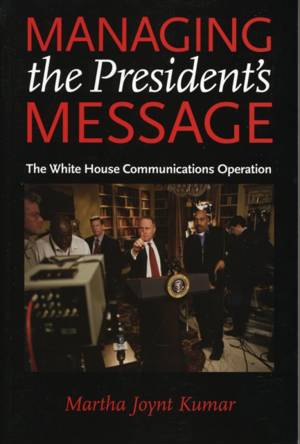
- Afhalen na 1 uur in een winkel met voorraad
- Gratis thuislevering in België vanaf € 30
- Ruim aanbod met 7 miljoen producten
- Afhalen na 1 uur in een winkel met voorraad
- Gratis thuislevering in België vanaf € 30
- Ruim aanbod met 7 miljoen producten
Zoeken
Managing the President's Message
The White House Communications Operation
Martha Joynt Kumar
Paperback | Engels
€ 41,95
+ 83 punten
Omschrijving
Political scientists are rarely able to study presidents from inside the White House while presidents are governing, campaigning, and delivering thousands of speeches. It's even rarer to find one who manages to get officials such as political adviser Karl Rove or presidential counselor Dan Bartlett to discuss their strategies while those strategies are under construction. But that is exactly what Martha Joynt Kumar pulls off in her fascinating new book, which draws on her first-hand reporting, interviewing, and original scholarship to produce analyses of the media and communications operations of the past four administrations, including chapters on George W. Bush and Bill Clinton. Kumar describes how today's White House communications and media operations can be at once in flux and remarkably stable over time. She describes how the presidential Press Office that was once manned by a single presidential advisor evolved into a multilayered communications machine that employs hundreds of people, what modern presidents seek to accomplish through their operations, and how presidents measure what they get for their considerable efforts. Laced throughout with in-depth statistics, historical insights, and you-are-there interviews with key White House staffers and journalists, this indispensable and comprehensive dissection of presidential communications operations will be key reading for scholars of the White House researching the presidency, political communications, journalism, and any other discipline where how and when one speaks is at least as important as what one says.
Specificaties
Betrokkenen
- Auteur(s):
- Uitgeverij:
Inhoud
- Aantal bladzijden:
- 400
- Taal:
- Engels
Eigenschappen
- Productcode (EAN):
- 9780801895593
- Verschijningsdatum:
- 8/04/2010
- Uitvoering:
- Paperback
- Formaat:
- Trade paperback (VS)
- Afmetingen:
- 152 mm x 226 mm
- Gewicht:
- 544 g

Alleen bij Standaard Boekhandel
+ 83 punten op je klantenkaart van Standaard Boekhandel
Beoordelingen
We publiceren alleen reviews die voldoen aan de voorwaarden voor reviews. Bekijk onze voorwaarden voor reviews.











